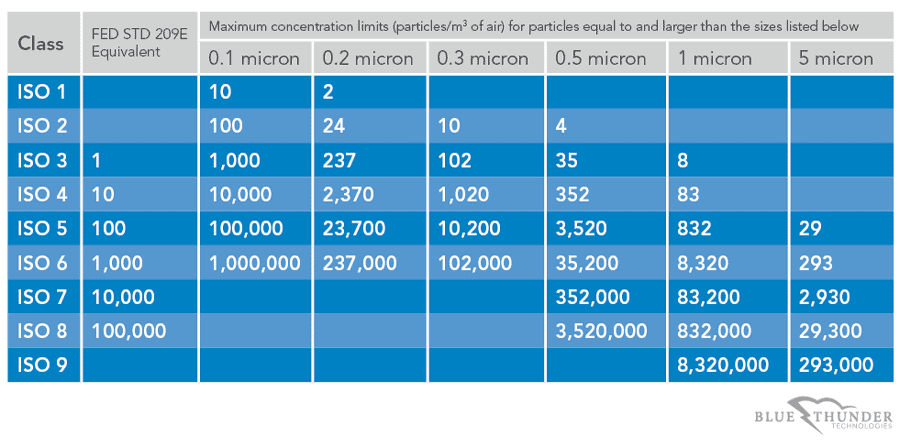
ISO 14644 Cleanroom Standards
What makes a clean room a cleanroom?
To some extent, ISO 14644 cleanroom standards.
A cleanroom is an enclosed room equipped to control the levels of airborne particulate matter. This control is achieved by air pressure and filters. Positive pressure keeps new particles from entering the clean area.
The International Organization for Standardization (ISO) says that clean rooms must not exceed a certain particulate count, measured in cubic meters. The amount stipulated for each cleanroom application depends on the class of air cleanliness required.
Contamination risks are micro-organisms from people in the room, and particulates from the processes taking place in the room. Consider that one person can shed 1 billion flakes of skin in a day.

View or Download our Cleanroom Classifications Chart Poster >>
How is Cleanliness Measured

To measure cleanliness, we consider the number of particles in the air. These can be measured in microns.
One micron is just one-hundredth the width of a human hair. You cannot see this, therefore, with the naked eye. The smallest particle seen without additional equipment is a 10-micron particle. That flake of human skin mentioned earlier measures around 35 microns.
Cleanrooms control the environment down to 0.01 and 0.05 micron particles.
Cleanliness can be measured with light scattering airborne particle counters (LSAPC), which determine the concentration of airborne particles. Measurement will take place for particles equal to and greater than the specified sizes and examines specified sampling locations.
Simply speaking, for ISO 14644-1 classification, threshold particles of 0.1 microns to 5 microns in size are considered. This standard applies in general to all cleanrooms.
Whereas cleanliness standards were once defined by the Federal Standard 209E, they have been replaced and simplified by ISO, with classifications 1 to 9.
Classification 1 is the cleanest. Under the FED STD 209E system, there was no equivalent for this level of cleanliness. Classification 9 is defined as room air. Not bad, but, sorry, not particularly clean.
Limits and Limitations of ISO 14644
You should note that this standard does not consider particle populations outside the given particle size range. For ultrafine or nano-scale particles (these are smaller than 0.1 microns), a separate standard is used to measure and address air cleanliness.
Equally, particles larger than 5 microns are considered macroparticles. Requirements here are stipulated by another standard.
Maintaining Standards
ISO standards are reviewed every five years. And you can trust us to keep a close eye on industry developments, too. We stay up-to-date with all changes, technological and regulatory, so that your cleanroom can be as effective and efficient as possible.
For equipment, materials, and service you can trust, give us a call at (860) 265-7995.